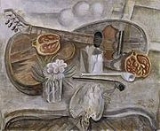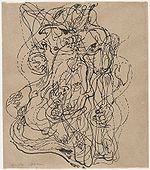
André Masson
Encyclopedia

France
The French Republic , The French Republic , The French Republic , (commonly known as France , is a unitary semi-presidential republic in Western Europe with several overseas territories and islands located on other continents and in the Indian, Pacific, and Atlantic oceans. Metropolitan France...
artist
Artist
An artist is a person engaged in one or more of any of a broad spectrum of activities related to creating art, practicing the arts and/or demonstrating an art. The common usage in both everyday speech and academic discourse is a practitioner in the visual arts only...
.
Biography
Masson was born in Balagny-sur-ThérainBalagny-sur-Thérain
Balagny-sur-Thérain is a village in northern France. It is designated municipally as a commune within the département of Oise.-References:*...
, Oise
Oise
Oise is a department in the north of France. It is named after the river Oise.-History:Oise is one of the original 83 departments created during the French Revolution on March 4, 1790...
, but was brought up in Belgium
Belgium
Belgium , officially the Kingdom of Belgium, is a federal state in Western Europe. It is a founding member of the European Union and hosts the EU's headquarters, and those of several other major international organisations such as NATO.Belgium is also a member of, or affiliated to, many...
. He began his study of art at the age of eleven in Brussels
Brussels
Brussels , officially the Brussels Region or Brussels-Capital Region , is the capital of Belgium and the de facto capital of the European Union...
, at the Académie Royale des Beaux-Arts
Académie Royale des Beaux-Arts
The Académie Royale des Beaux-Arts in Brussels is an art school, founded in 1711.The faculty and alumni of ARBA include some of the most famous names in Belgian painting, sculpture, and architecture: James Ensor, Rene Magritte, and Paul Delvaux...
under the guidance of Constant Montald
Constant Montald
Constant Montald was a Belgian painter, muralist, sculptor, and teacher.Montald trained at the Royal Academy of Fine Arts in Ghent, then lived and studied briefly in Paris with fellow artist Henri Privat-Livemont at the Ecole des Beaux-Arts...
, and later he studied in Paris
Paris
Paris is the capital and largest city in France, situated on the river Seine, in northern France, at the heart of the Île-de-France region...
. He fought for France during World War I
World War I
World War I , which was predominantly called the World War or the Great War from its occurrence until 1939, and the First World War or World War I thereafter, was a major war centred in Europe that began on 28 July 1914 and lasted until 11 November 1918...
and was seriously injured.
Artistic Works
His early works display an interest in cubismCubism
Cubism was a 20th century avant-garde art movement, pioneered by Pablo Picasso and Georges Braque, that revolutionized European painting and sculpture, and inspired related movements in music, literature and architecture...
. He later became associated with surrealism
Surrealism
Surrealism is a cultural movement that began in the early 1920s, and is best known for the visual artworks and writings of the group members....
, and he was one of the most enthusiastic employers of automatic drawing, making a number of automatic works in pen and ink. Masson would often force himself to work under strict conditions, for example, after long periods of time without food or sleep, or under the influence of drugs. He believed forcing himself into a reduced state of consciousness would help his art be free from rational control, and hence get closer to the workings of his subconscious mind.
From around 1926 he experimented by throwing sand and glue onto canvas and making oil paintings based around the shapes that formed. By the end of the 1920s, however, he was finding automatism
Automatism
Automatism may refer to:*Automatic behavior, spontaneous verbal or motor behavior; an act performed unconsciously. Defendants have been found not guilty due to an automatism defense ....
rather restricting, and he left the surrealist movement and turned instead to a more structured style, often producing works with a violent or erotic theme, and making a number of paintings in reaction to the Spanish Civil War
Spanish Civil War
The Spanish Civil WarAlso known as The Crusade among Nationalists, the Fourth Carlist War among Carlists, and The Rebellion or Uprising among Republicans. was a major conflict fought in Spain from 17 July 1936 to 1 April 1939...
(he associated once more with the surrealists at the end of the 1930s).
Under the German
Nazi Germany
Nazi Germany , also known as the Third Reich , but officially called German Reich from 1933 to 1943 and Greater German Reich from 26 June 1943 onward, is the name commonly used to refer to the state of Germany from 1933 to 1945, when it was a totalitarian dictatorship ruled by...
occupation of France
Vichy France
Vichy France, Vichy Regime, or Vichy Government, are common terms used to describe the government of France that collaborated with the Axis powers from July 1940 to August 1944. This government succeeded the Third Republic and preceded the Provisional Government of the French Republic...
during World War II
World War II
World War II, or the Second World War , was a global conflict lasting from 1939 to 1945, involving most of the world's nations—including all of the great powers—eventually forming two opposing military alliances: the Allies and the Axis...
, his work was condemned by the Nazis as degenerate
Degenerate art
Degenerate art is the English translation of the German entartete Kunst, a term adopted by the Nazi regime in Germany to describe virtually all modern art. Such art was banned on the grounds that it was un-German or Jewish Bolshevist in nature, and those identified as degenerate artists were...
. With the assistance of Varian Fry
Varian Fry
Varian Mackey Fry was an American journalist. Fry ran a rescue network in Vichy France that helped approximately 2,000 to 4,000 anti-Nazi and Jewish refugees to escape Nazi Germany and the Holocaust.-Early life:...
in Marseille
Marseille
Marseille , known in antiquity as Massalia , is the second largest city in France, after Paris, with a population of 852,395 within its administrative limits on a land area of . The urban area of Marseille extends beyond the city limits with a population of over 1,420,000 on an area of...
, Masson escaped the Nazi regime on a ship to the French island of Martinique
Martinique
Martinique is an island in the eastern Caribbean Sea, with a land area of . Like Guadeloupe, it is an overseas region of France, consisting of a single overseas department. To the northwest lies Dominica, to the south St Lucia, and to the southeast Barbados...
from where he went on to the United States. Upon arrival in New York City, U.S. customs officials inspecting Masson's luggage found a cache of his erotic drawings. Denouncing them as pornographic, they ripped them up before the artist's eyes. Living in New Preston, Connecticut
New Preston, Connecticut
New Preston is a rural village in the northwestern corner of the town of Washington in Litchfield County, Connecticut, United States. The village is also at the center of New Preston CDP, a census-designated place , whose population was 1,110 at the 2000 census.-Geography:According to the United...
his work became an important influence on American abstract expressionists, such as Jackson Pollock
Jackson Pollock
Paul Jackson Pollock , known as Jackson Pollock, was an influential American painter and a major figure in the abstract expressionist movement. During his lifetime, Pollock enjoyed considerable fame and notoriety. He was regarded as a mostly reclusive artist. He had a volatile personality, and...
. Following the war, he returned to France and settled in Aix-en-Provence
Aix-en-Provence
Aix , or Aix-en-Provence to distinguish it from other cities built over hot springs, is a city-commune in southern France, some north of Marseille. It is in the region of Provence-Alpes-Côte d'Azur, in the département of Bouches-du-Rhône, of which it is a subprefecture. The population of Aix is...
where he painted a number of landscape
Landscape art
Landscape art is a term that covers the depiction of natural scenery such as mountains, valleys, trees, rivers, and forests, and especially art where the main subject is a wide view, with its elements arranged into a coherent composition. In other works landscape backgrounds for figures can still...
s.
Masson drew the cover of the first issue of Georges Bataille
Georges Bataille
Georges Bataille was a French writer. His multifaceted work is linked to the domains of literature, anthropology, philosophy, economy, sociology and history of art...
's review, Acéphale
Acéphale
Acéphale designates both a public review created by Georges Bataille and a secret and esoteric society formed by Bataille and some other members who had sworn to keep silence.-Acéphale, the review:Dated 24 June 1936, the first issue was composed of only eight pages...
, in 1936, and participated in all its issues until 1939. His stepbrother, the psychoanalyst Jacques Lacan
Jacques Lacan
Jacques Marie Émile Lacan was a French psychoanalyst and psychiatrist who made prominent contributions to psychoanalysis and philosophy, and has been called "the most controversial psycho-analyst since Freud". Giving yearly seminars in Paris from 1953 to 1981, Lacan influenced France's...
, was the last private owner of Gustave Courbet
Gustave Courbet
Jean Désiré Gustave Courbet was a French painter who led the Realist movement in 19th-century French painting. The Realist movement bridged the Romantic movement , with the Barbizon School and the Impressionists...
's provocative painting L'Origine du monde
L'Origine du monde
L’Origine du monde is an oil-on-canvas painted by French artist Gustave Courbet in 1866. It is a close-up view of the genitals and abdomen of a naked woman, lying on a bed with legs spread...
(The Origin of the World); Lacan asked Masson to paint a surrealist
Surrealism
Surrealism is a cultural movement that began in the early 1920s, and is best known for the visual artworks and writings of the group members....
variant.
Family
His son, Diego MassonDiego Masson
Diego Masson is a French conductor, composer, and percussionist.The son of artist André Masson and brother of the singer and actor Luís Masson, Diego Masson studied piano and composition at the Paris Conservatoire...
(born 1935), is a conductor, composer, and percussionist, while another son, Luis, is an actor. His daughter, Lily Masson (born 1920), is a painter.
External links
- http://www.tate.org.uk/servlet/ArtistWorks?cgroupid=999999961&artistid=1590&page=1Masson at the Tate GalleryTate GalleryThe Tate is an institution that houses the United Kingdom's national collection of British Art, and International Modern and Contemporary Art...
.] - Short biography.
- Müller-Yao, Marguerite: Informelle Malerei und chinesische Kalligrafie, Dortmund 2002, ISBN 3-611-01062-6

